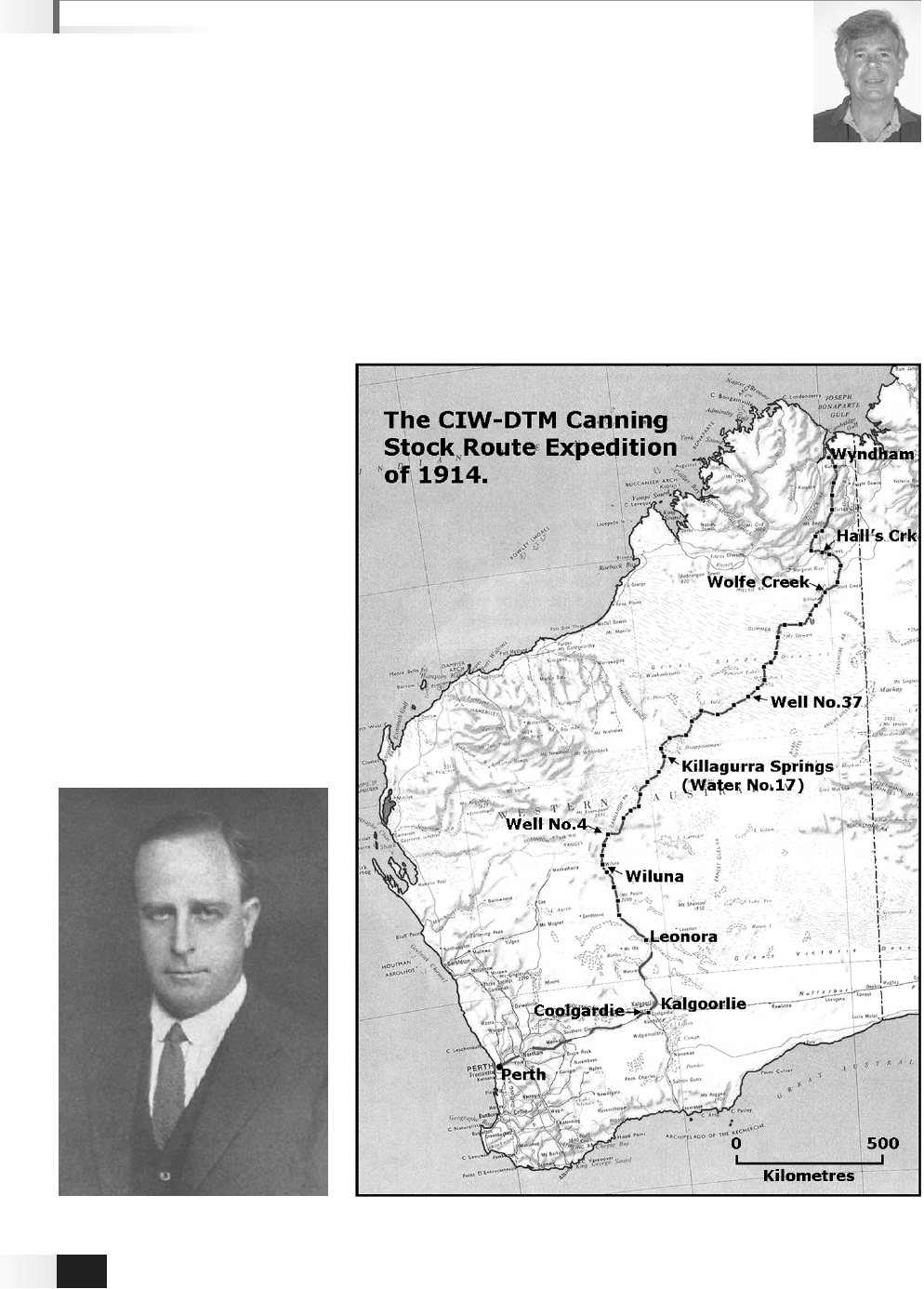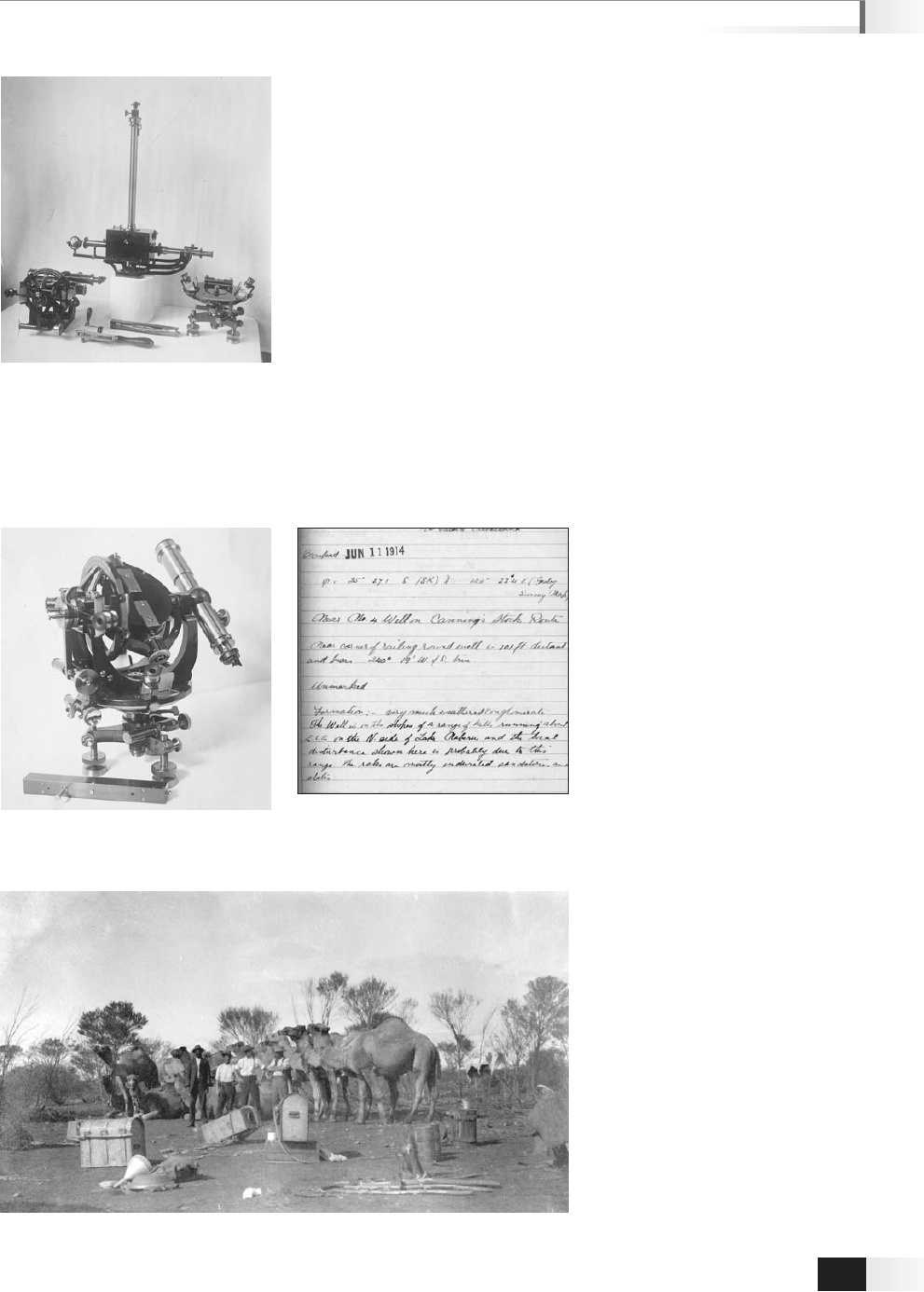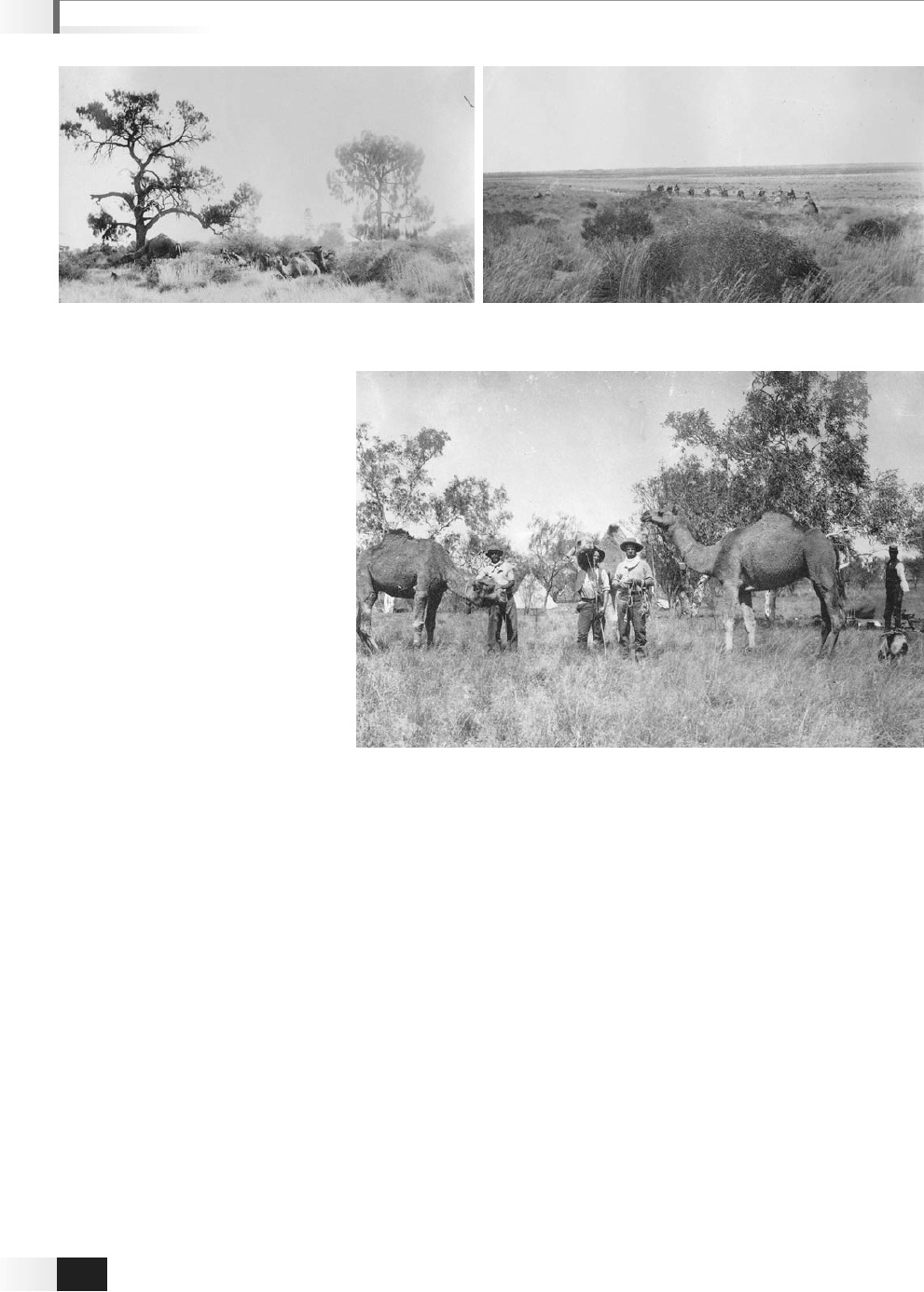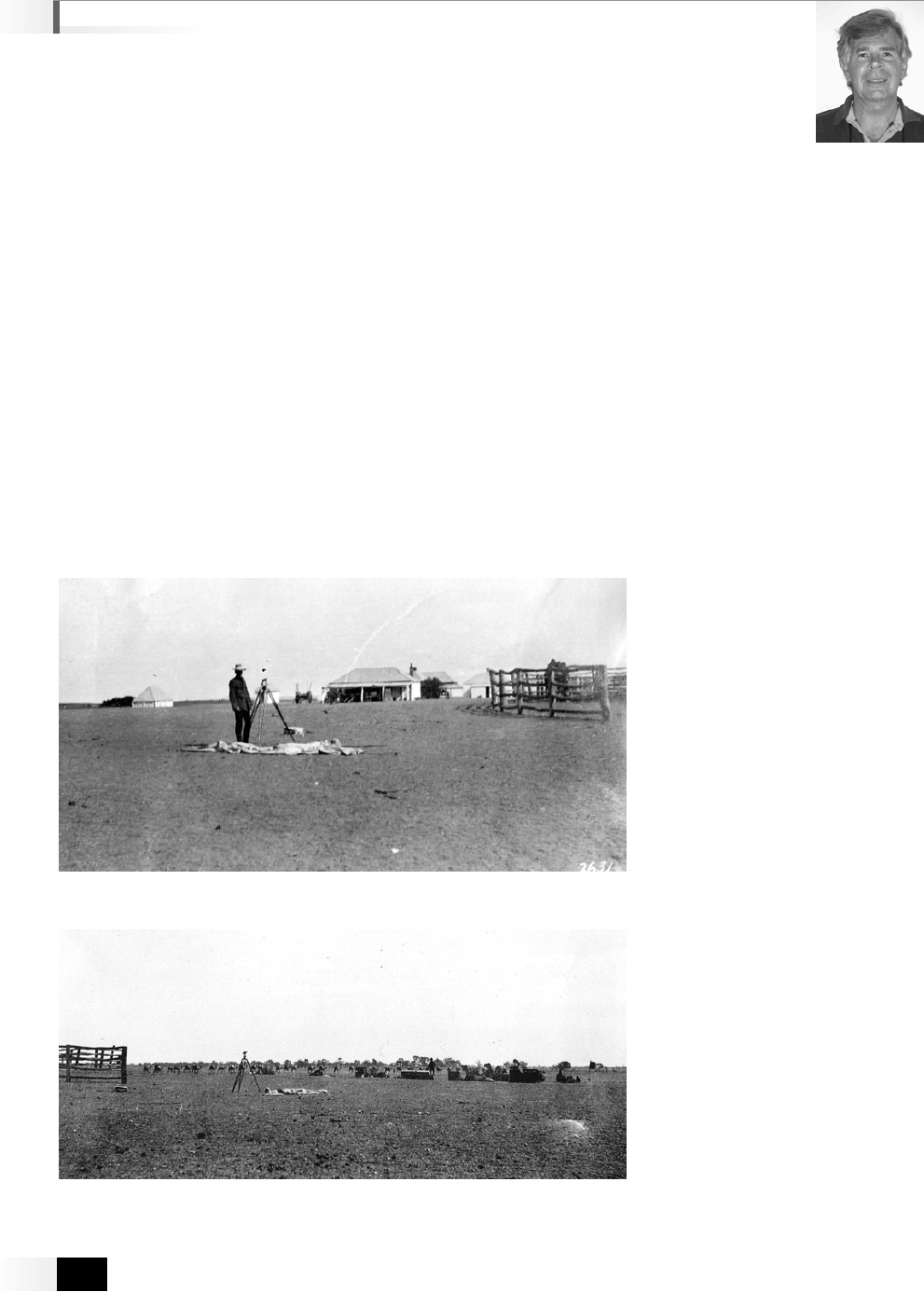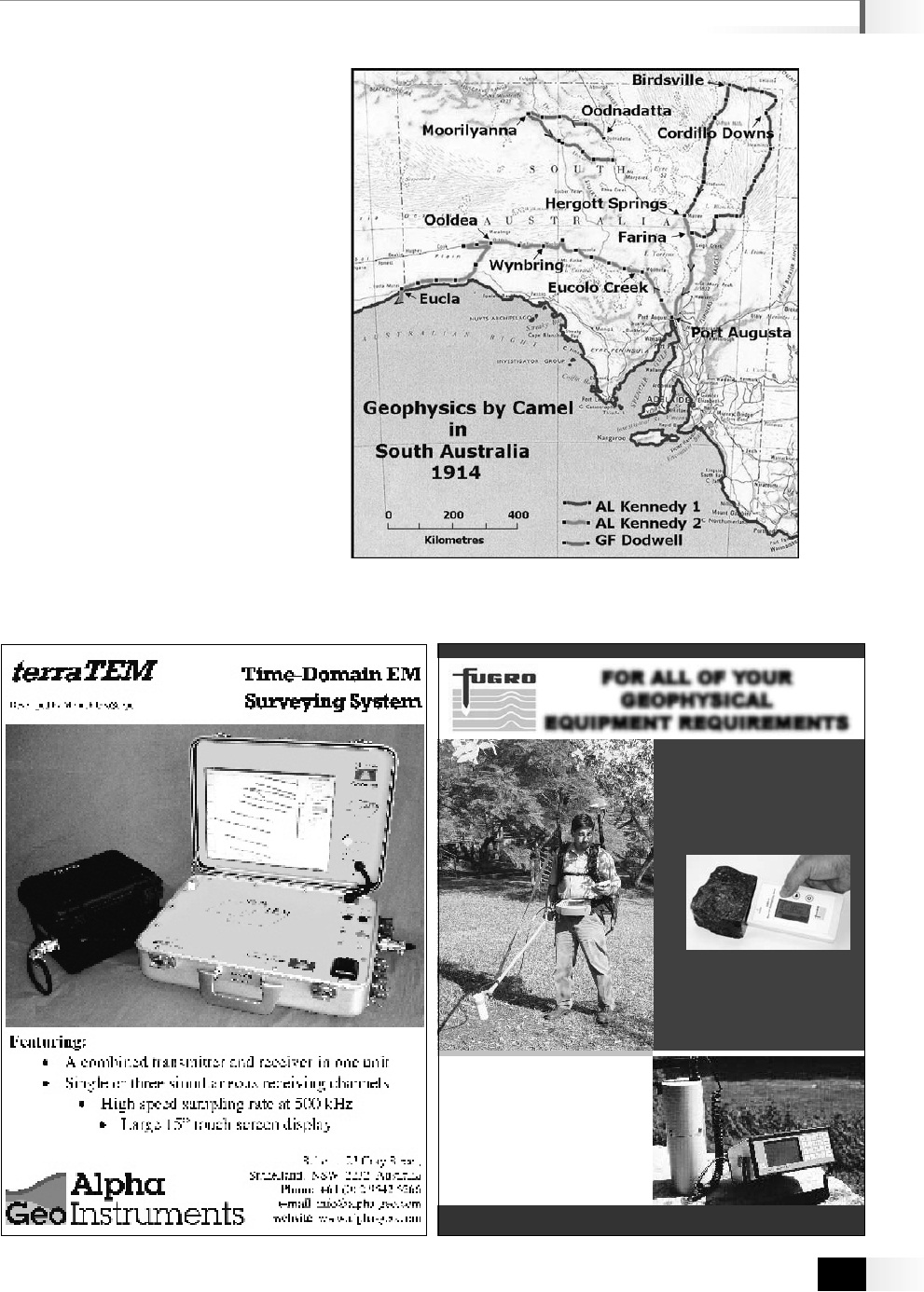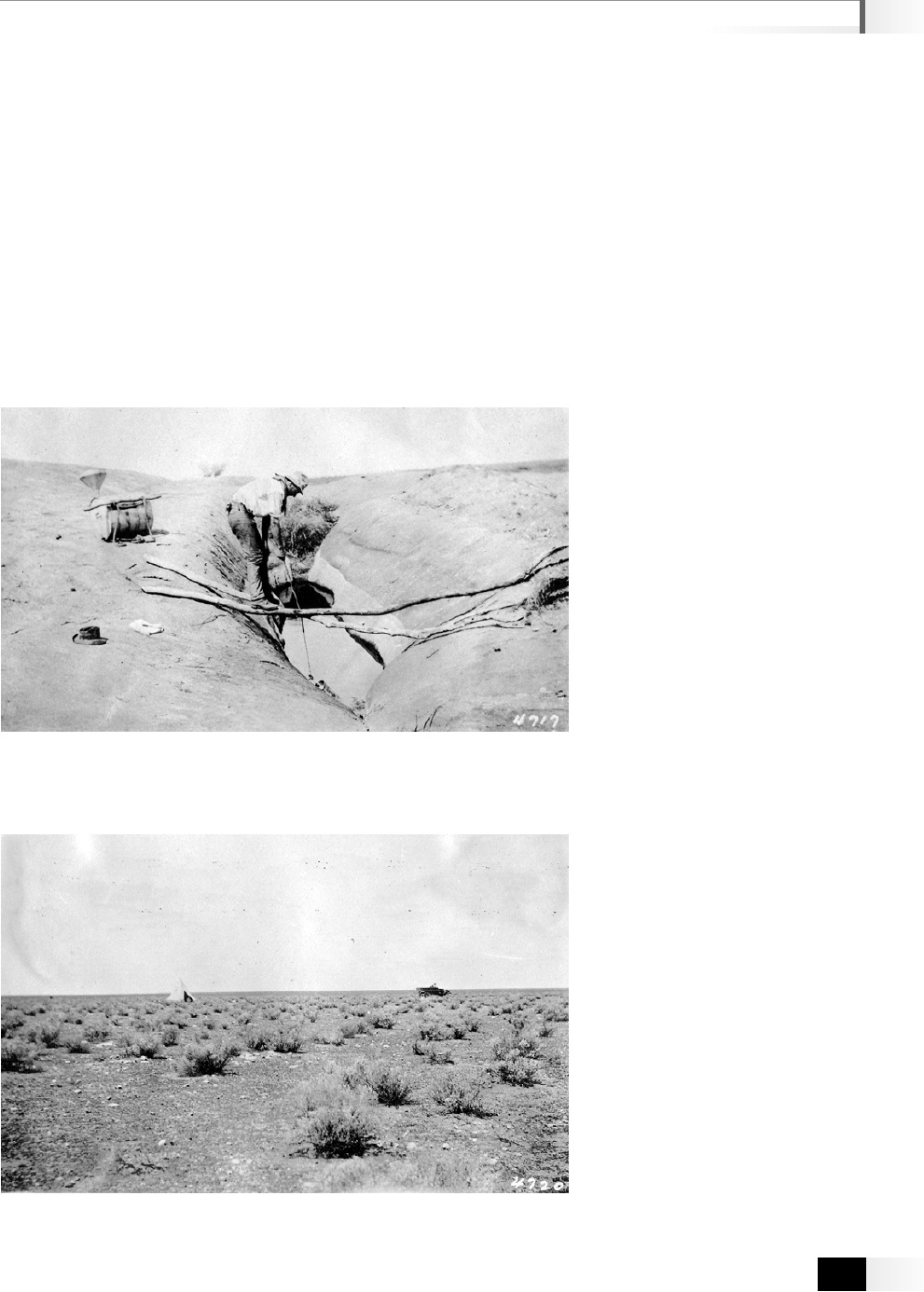GEOPHYSICAL HISTORY by Doug Morrison
sth.lands@optusnet.com.au
90 Years Ago - some
This new invention was
Perth Wiluna observations
primarily designed for
pioneering field trips
the measurement of
By early April 1914 Edward Kidson had
magnetic inclination
organised twelve camels - three of which
(Part I)
(dip) and was a great
were riding camels - from the Water Supply
Department of Western Australia and hired
boon to field operations as the measurements
A geophysicist and some
camel drivers Messrs Clarke and Cronin who
could be made quickly the alternative
camels
were already fitting out the team in Kalgoorlie.
method, using dip circles, took hours to set
up, stabilize and read.
Later in the month Kidson reoccupied the
known Perth magnetic observatory site to
Kidson and his camels
calibrate his newly arrived `Magnetometer-
Kidson, with all of his equipment, departed
The camels names were Ben, Syd, Skipper,
Earth Inductor No. 24' (Figures 3 and 4).
Perth by train on the 8th May 1914 and
Lion, Scorcher, Niziam, Chunks, Chunky,
the following day, during a short stopover,
Longlegs, Kangaroo, Lindsay and Goolam; and
the geophysicist's name was Edward Kidson,
the chief observer in Australia for the Carnegie
Institution of Washington, Department of
Terrestrial Magnetism (CIW/DTM). The date
was 16th August 1914 (Figure 1).
The place was Flora Valley Station, near Halls
Creek in the East Kimberley region of Western
Australia, and when the weary Kidson and
compatriots (Messrs Clarke, Cronin, Ryan and
their exceptional aboriginal tracker "Nipper")
halted they had just completed a journey by
camel of almost two thousand kilometres that
had started in Kalgoorlie some three months
earlier (12th May 1914). They had traversed
the Great Sandy Desert from Wiluna, along
the remote, rarely travelled and potentially
dangerous, Canning Stock Route (Figure 2).
Little did the camels know they were about to
turn around and make the return trip!
Fig. 1. Edward Kidson (1882-1939) unsourced
Fig. 2. Kidson's expedition route and magnetic station locations.
from Kidson, 1941.
16
Preview
APRIL 2005
GEOPHYSICAL HISTORY
reoccupied a previously established mag
expedition have survived in the archives of the
station at Coolgardie. On the 20th May, along
CIW/DTM-Geophysical Laboratory Library
in Washington DC. A biography written and
with Clarke and Cronin, twelve camels, a
cook named Mr. Ryan, the experienced
published in 1941 by Kidson's widow also
aboriginal tracker Nipper and a dog or two,
includes snippets from a private diary he kept
Kidson departed Leonora firstly to Wiluna
during his travels; so we are quite lucky that
his field operations can be described in some
- observing inclination, declination and
detail and in some cases viewed as well.
horizontal intensity along the way at Lawlers,
Lake Miranda, Logan Well and Abercromby
Well. Kidson, from the start, set procedures
Some of Kidson's private diary entries show he
which were to be maintained throughout the
was anxious for the safety of the expedition, for
expedition - his observations, for instance,
instance, he mentioned he had received "urgent
were made at alternate camps and Sundays
advice" at Wiluna to be careful of the desert
were always a day of rest for both men and
aborigines "as they were both treacherous and
camels (Figure 5).
unreliable". This somewhat uncomfortable
Fig. 3. CIW/DTM instrumentation circa 1913.
observation (to us) probably originated from
Magnetometer (centre), `Earth Inductor No. 23'
the police at Wiluna, although Kidson does not
The Canning Stock Route some
(at left), compass declinometer (at right). In the
expand. The Wiluna police had travelled up the
front is the boxed needle for the declinometer
concerns
stock route a few years earlier investigating
and the winder/spinner for the earth inductor coil.
There was also a `magnetically cleaned' theodolite.
Kidson's narrative reports, observation tables,
the murders of two drovers, Shoesmith and
All instruments fitted to the same tripod base and
cahiers i.e., field notebooks (Figure 6) and
Thomson, near Well No. 37 and the track
packed into a single carrying case. Courtesy CIW/
thirty or so photographs taken during his
had not been travelled since. Kidson certainly
DTM-GL Library, instrument photo #182.
took the advice very seriously, for a number
of times he noted in his diary that they were
being followed by small groups of aborigines
and that he had warned them off.
Scenery and Well No.37
Kidson was very impressed with the abilities of
his aboriginal tracker Nipper. Nipper had made
three journeys along the route with Alfred
Canning during the well construction and
despite the track not being used for over three
years he was able to follow the camel pads
made by Canning's construction expeditions
with ease.
Fig. 6. A page from Kidson's Observer Cahier
No.232, 11th June 1914 at No. 4 Well. Includes a
Fig. 4. Kidson's actual `Earth Inductor No. 24' seated
description of the site, a mention of a local magnetic
The scenery at a number of the watering places
on the compass declinometer. Needle box at front.
disturbance and the general geology. Courtesy CIW/
Courtesy CIW/DTM-GL Library, instrument photo
also impressed Kidson he was particularly
DTM-GL Library.
#197.
attracted to Killagurra Springs (No. 17 Water),
as are most visitors, apparently. Kidson
recorded the waterholes there were teeming
with life including fish and large freshwater
crayfish. It was at this camp that Kidson
walked across the hills to the nearby Durba
Spring and according to his diary he travelled
alone "with gun and barometer"!
As the expedition approached Well No. 37
Kidson took extra precautions for, in his
correspondence, he says that at Wanda (Well
No. 36) he fortified his camp, he made an
enclosure of the boxes, saddles and water tanks
and they all slept inside the enclosure with a
tarpaulin spread over. The camels were tied
near to the camp rather than being hobbled.
Kidson may have had some grounds to be
Fig. 5. Preparations at Wiluna circa 3rd June 1914. Courtesy CIW/DTM-GL Library photo #4154.
17
Preview
APRIL 2005
GEOPHYSICAL HISTORY
Fig. 7. The notorious Well No. 37, 18th July 1914. Note the dense bush and
Fig. 8. On the shores of the remote Tobin Lake (salt) between Well Nos. 39 and 40,
spinifex. Courtesy CIW/DTM-GL Library photo #4170.
circa 20th July 1914.Tobin, a member of Alfred Canning's 1906-09 expedition had
been murdered nearby. Courtesy CIW/DTM-GL Library photo #4173.
careful as he says the dog Nellie growled
throughout the night we will never know
the reason (Figures 7 and 8). Well No. 37 has
gained a notorious history. In 1922 there was
another murder there when the prospector Jock
McLernon was clubbed to death.
Hall's Creek to Wyndham
On reaching Flora Valley Station, Kidson
"received hearty greetings" from the owners,
the Gordon brothers and the explorer/cattleman
Gordon Buchanan. Kidson then travelled to
the (old) Halls Creek telegraph station to send
his telegrams, collect his mail and purchase a
horse and dray.
Following a week or so of rest for his men
and, especially, the camels, the crew said their
goodbyes to Kidson and commenced their long
Fig. 9. At Wolfe Creek circa 11th August 1914. Note the magnetometer observation tent in the background.
haul back to Leonora arriving there on the
Courtesy CIW/DTM-GL Library photo #4179.
23rd November (Figure 9).
some topographical features near the Canning
cousin Ewan Morrison who made the effort to
On the 29th August, Gordon Buchanan, with
Stock Route Well Nos. 33 and 35; firstly by
visit the library, inspect the field notes, reports
Kidson Bluff and then by Kidson Track, the
business to be done in Wyndham, joined Kidson
and photographs. It has been worth it.
in the horse and buggy from Halls Creek
old WAPET access road to the capped and
(with Buchanan doing the driving apparently).
aptly named KIDSON oil well.
References
Kidson was to observe eight stations on this
journey to Wyndham, arriving there on the 20th
Sir Douglas Mawson named a site in Antarctica
Bauer, L. A., Fleming, J. A., Fisk, H. W., and
September and then embarking (conveniently)
after Kidson, but that, and Kidson's significant
Peters, W. J., 1921, Magnetic work in Western
Australia, April to October 1914, in Land
the following day on the "Kwinana" for Perth.
influence in meteorology is another story.
Magnetic Observations, 1914-1920: Researches
From the time of his departure from Leonora in
of the Department of Terrestrial Magnetism, Vol.
late May, Kidson had observed and accurately
IV Carnegie Institution of Washington Publication
,
Acknowledgements
positioned magnetic inclination, declination
No. 175, 172-174.
and horizontal intensity measurements at 48
Bamford, M., Gard, E., Gard, R., and Hewitt, D.,
sites.
It is with some degree of gratitude I thank the
1992 (revised 1998), The Australian Geographic
Carnegie Institution of Washington, DTM-
Book of the Canning Stock Route: Australian
Geographic Pty Ltd.
Geophysical Laboratory Library for access to
The memory of Kidson as both an explorer
and pioneer geophysicist has faded, but his
their Australian records and photographs. In
Kidson, I. M., 1941, Edward Kidson O.B.E. (Mil),
M.A., D.Sc., F.Inst.P., F.R.S.N.Z. Late Director
reports, field notes and photographs from this
particular I would like to thank their librarian,
of Meteorological Services in New Zealand:
and other expeditions have survived in the
Shaun Hardy for his interest and complete co-
Whitcombe and Tombs, Christchurch, New
CIW/DTM-GL Library in Washington. It is
operation with my requests to publish some of
Zealand.
also good to know that he is remembered by
the old CIW/DTM images. Thanks also to my
18
Preview
APRIL 2005
GEOPHYSICAL HISTORY by Doug Morrison
sth.lands@optusnet.com.au
90 Years Ago - some
to the remote Everard and Musgrave Ranges.
and George Dodwell in
Travel by camel may not have been the
South Australia. The
pioneering field trips
Adelaide academic,
preferred mode of transport in 1914 but it was
Professor Kerr Grant
essential for any remote work (Figure 3).
(Part II)
also became involved
when he assisted Dodwell with a number of
Kidson's helpers
Edward Kidson, his
field observations.
observers and some more
In the period 1911-1915 a number of
camels
geophysical observers were employed in
The DTM had supplied Kidson with the then
Australia by the Carnegie Institution of
state-of-the-art equipment. He had observatory
Washington, Department of Terrestrial
Edward Kidson's 1914 expedition along
standard theodolite-magnetometers (and in
Magnetism (CIW/DTM) to measure and
the Canning Stock Route (see Preview 115)
1914 the newly invented earth inductors),
was not the first nor the only geophysical
map, amongst other things, the earth's regional
compass declinometers, observatory standard
expedition in Australia where camels have
magnetic field, i.e., declination, inclination
dip circles, chronometers and watches,
been the mode of transport, for in 1912 Kidson
and intensity. In addition to Edward Kidson,
thermometers, barometers and cameras he
had, with his assistant F.W. Cox, travelled and
the first observers were Fred Brown, Eric
was very well equipped. By 1914, in addition
observed from Oodnadatta to Daly Waters
Webb, Alec Kennedy, F.W. Cox and W.C.
to his own party on the Canning Stock Route,
along the old overland telegraph line (Figure
Parkinson (Figure 4). There were to be other
he also had three other field parties operating
1 and 2) and then later, in 1914, Alec Kennedy,
DTM observers in the following years and all
in Australia.
one of Kidson's observers made two forays into
were to carry out pioneering geophysical field
remote desert areas of South Australia as did
surveys. Kidson received great co-operation
To Innamincka, Cordillo Downs and
the South Australian Government Astronomer
and observational assistance from the various
Birdsville
George Dodwell when he joined the geologist
state government astronomers, including
Robert Lockhart Jack on a historic expedition
Pietro Baracchi and J.M Baldwin in Victoria
In mid-1914 Alexander (known as Alec)
Lorimer Kennedy, the DTM geophysical
observer and previously a "magnetician" on
Mawson's Antarctic 1912-13 expedition led a
camel party from Farina, north of Leigh Creek
on the Adelaide - Alice Springs telegraph line.
The route went up the Strzelecki Creek to
Innamincka and Cordillo Downs, then across
to Birdsville and back down the Birdsville
Track to Hergott Springs (Marree) -a trip of
over one thousand kilometres (Figure 5).
For this trip Kennedy had engaged an Afghan
camel driver with five bull camels and the
journey along the Strzelecki Creek went very
well - with plenty of feed and numerous wells
and waterholes however things came to a
sudden halt when the camels wandered off
Fig. 1. Kidson's magnetic station site at Charlotte Waters NT showing meat house at left and blacksmith's shop
during the first night at Innamincka and after
at right. 8th June 1912. Courtesy CIW/DTM-GL Library photo #2631.
a fruitless seven day search it was "by good
fortune, we found three strange [sic] camels
in the bush country, with which I decided to
continue the journey, although it necessitated
abandoning some of the supplies and only
allowed us one camel for riding". Kennedy's
travel after Innamincka was slow as a
consequence, at walking pace, and with scanty
feed it became more frustrating when they were
then held up by nine days of continuous rain!
Kennedy, despite these inconveniences, made
geophysical and meteorological observations
throughout the trip.
Fig. 2. Mag station at Charlotte Waters NT 8th June 1912.The camel train of Mr. F.H. Marsh of Oodnadatta in
On reaching Hergott Springs on the 5th July
the background enroute to Alice Springs. Kidson's camp in the foreground. Courtesy CIW/DTM-GL Library photo
a message was relayed by telegraph that the
#2632.
20
Preview
JUNE 2005
GEOPHYSICAL HISTORY
camels had already made their own way home
to Farina from Innamincka (360 km as the
crow flies).
Non-magnetic "gibbers"
Kennedy made observations (declination,
inclination and intensity) at twenty-four
regularly spaced stations on the trip and
in his report he noted the average time per
station was 3.7 days and the average cost was
US$27.07 per station.
In his reports Kennedy mentioned the effect
of geology at each of his observations, albeit
briefly, and his final summary for this trip
read - "The great part of the area traversed is
a lower and upper cretaceous deposit of sand,
sandstone, quartzite, jasper, etc. There are
extensive areas of land covered with desert
sandstone boulders, locally known as `gibbers',
which consist mainly of sandstone indurated by
siliceous infiltrations. Most of the `gibbers' are
red, coated with oxides of iron, the outcome of
arid conditions. These oxides apparently have
Fig. 3. Kennedy and Dodwell's South Australian expedition routes and magnetic station locations.
little effect on the magnetic conditions".
FOR ALL OF YOUR
GEOPHYSICAL
EQUIPMENT REQUIREMENTS
Largest, most extensive range
of geophysical products
in Australasia.
Distributors of leading-edge
instrumentation from
manufacturers world-wide.
Support throughout Australia,
with competitive rates
& fast turn-around.
Sales, Rentals,
Repairs & Technical Support
FUGRO INSTRUMENTS
21 Mellor Street
West Ryde NSW 2114
Sydney Australia
Phone:
+61 2 8878 9000
Fax:
+61 2 8878 9012
sales@fugroinstruments.com
www.fugroinstruments.com
Exploration
Engineering
Environmental
21
Preview
JUNE 2005
GEOPHYSICAL HISTORY
By "caravan" to the Nullarbor
Immediately after this expedition to the north-
east corner of South Australia, Kennedy,
under instructions previously issued by
Edward Kidson (who was at that time on
the Canning Stock Route) organised another
"caravan" Kennedy's description - that was to
ambitiously make magnetometer observations
all the way from Port Augusta to Kalgoorlie
Fig. 4. Some CIW/DTM
"magneticians", left to
along the then partly surveyed and constructed
right: Fred Brown,W. C.
transcontinental railway line a long and
Parkinson both in DTM
difficult trip. Before his departure Kennedy,
uniform, Edward Kidson
assisted by the government astronomer George
and Alec Kennedy.
Courtesy CIW/DTM-GL
Dodwell, calibrated his magnetometer by
Library photo #4732.
reoccupying a known Port Augusta observation
site. It was typical of all the DTM observers to
make great effort to ensure the accuracy and
calibration of their measurements.
Fig. 5. Some gibber
plains at Cordillo
The camels for the trip west, all twelve of
Downs, South Australia.
them, were initially described by Kennedy as
Station buildings in
"a fine strong lot" and had been driven all the
the background and
way from Hergott Springs by the Adelaide
Kennedy's observation
tent in foreground. 28th
based camel driver Tom Dare over 300 km.
May 1914. Courtesy
On the 19th August 1914 Kennedy, with his
CIW/DTM-GL Library
friend the engineer F.M. Best, Tom Dare and
photo #4684.
the camels, departed Port Augusta and despite
being given experienced advice not to attempt
the trip due to the serious drought conditions
they proceeded (Figure 6).
No water on the Nullarbor
The expedition should never have continued
and was under extreme stress from the start,
with lack of feed and water and then the
discovery that only four of the camels were
tamed pack animals, the rest being wagon
camels a big difference! The condition of
the camels, most of which were very unruly,
deteriorated quickly and reached crisis point
at Tarcoola, where it was found there was no
water - none at all! All of the water at the time
Fig. 6. Kennedy's expedition travelling along Eucolo Creek, South Australia after passing the then construction
was being carted in (by camel) at US$4.50 per
railhead circa 29th August 1914. Courtesy CIW/DTM-GL Library photo #4699.
100 gallons.
Kennedy, with some deviations to native wells
the railway surveyors) and using his motor
Despite Kennedy's plans to find alternate
for water, continued on with the expedition as
vehicle for transport, observed two stations
ways to finish his observations to Kalgoorlie,
far as Ooldea Bore but it became impossible
further out into the Nullarbor (Figure 8) but
Edward Kidson (then back in Perth) called
Kennedy was to have no choice other than to
when it was found the next known water along
it all off on the 10th October 1914 and Tom
abort the travel along the railway route. He
Dare was immediately instructed to return to
the partly surveyed route was 340 km away at
Hergott Springs with the camels, a long haul
Bore No.4 in Western Australia. The expedition
was forced to backtrack with the camels south
of about one thousand kilometres.
was not capable of crossing such a stretch
from Ooldea to the coastal overland telegraph
without water (Figure 7).
line at White Well and from there travel west
Kennedy went on to make a series of repeat
to Eucla, observing a number of mag stations
At Ooldea, Kennedy "availed himself of " Mr
along the way.
observations out the back of the Eucla pub
T.R. Nealyon of Fowler's Bay (a supplier to
while awaiting his embarkation to Perth, not
22
Preview
JUNE 2005
GEOPHYSICAL HISTORY
departing from there until the 8th November
commented on both the geology and the
Alec Kennedy was to resign shortly thereafter
magnetic environment encountered on the
from the DTM and along with a number of
on the supply steamer Eucla (which arrived
his compatriots, including Kidson and Webb,
only once every three months). He reported
Nullarbor:
to Kidson in Perth on the 15th Nov 1914
and like most of their generation, went off
where they were to compare and calibrate
"The country is magnetically disturbed
to war.
between Gilbert's Well and Ooldea. The
their systems.
geological formation is pleistocene and
It is with gratitude I again thank the
pliocene sands, limestone, etc., overlying
Carnegie Institution of Washington, DTM-
An expensive trip
granites and gneisses, which outcrop in various
Geophysical Laboratory Library for access
Kennedy, in his final report to the CIW/DTM,
places. Mount Christie, about 20 miles north-
to their Australian records and photographs
calculated the average field expenses for
west of Wynbring Rock-Hole, is known as a
and in particular thanks go to their librarian,
Shaun Hardy, for his continued interest and
the thirty or so observations he had made
magnetic hill. Between Ooldea and Eucla there
co-operation.
from Port Augusta to Eucla was US$113.50
is less disturbance, the country being mainly
per station and that was really expensive! It
the Miocene and Eocene limestones of the
should be mentioned his report also briefly
Nullarbor Plain."
References:
Bauer, L. A., and Fleming, J. A., 1915,
Researches of the Department of Terrestrial
Magnetism, Volume II, Land Magnetic
Observations 1911-1913 and Reports on
Special Researches.
Bauer, L. A., Fleming, J. A., Fisk, H. W.,
and Peters, W. J., 1921, Researches of the
Department of Terrestrial Magnetism,
Volume IV Land Magnetic Observations
,
1914-1920.
Kidson, Isabel M., 1941, Edward Kidson
O.B.E. (Mil), M.A., D.Sc., F.Inst.P.,
F.R.S.N.Z. late Director of Meteorological
Services in New Zealand.
Fig. 7. F.M. Best filling camel tanks from the remote Wynbring Rockhole, circa 16th September 1914. Courtesy
CIW/DTM-GL Library photo #4717.
Fig.8. Kennedy's "Bore B" magnetic station on the Nullarbor Plain. Mr.T. R. Nealyon's motor vehicle at the right.
26th September 1914. Courtesy CIW/DTM-GL Library photo #4720.
23
Preview
JUNE 2005
